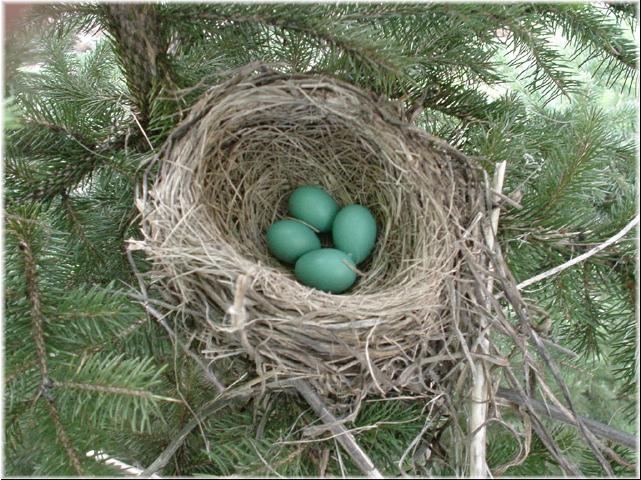The Story of Robin Eggs
Laying Eggs
Most birds lay their eggs at sunrise, but not robins. They lay their eggs at mid-morning, after feasting on worms. For robins, this makes good sense. Worms are most available before the sun gets too high. A robin can then fly over to her nest and lay her eggs easily, but most other birds seem to need a long period of quiet before they can lay eggs.
One Day at a Time
Robins lay only one egg per day for good reasons. Female birds have one working ovary, unlike mammals, which have two. Ovaries are the organs where eggs are produced. A bird's ovary looks like a tiny bunch of different-sized grapes. These are the ova, or actually the yolks. The one ovum about to be released looks huge. One or two are about half this size, a few more are a bit smaller, and the rest of the ova are tiny. About once a day, the largest yolk is ovulated. That means it pops off the ovary and starts traveling down a tube to the outside of the robin's body. This tube is called the oviduct.
How Do Eggs Form?
If a female robin has mated with a male, the yolk will become fertilized. If the robin hasn't mated, the yolk still goes down the oviduct and will be laid like a normal robin egg, but it won't develop into a chick. As the yolk travels through the oviduct, the tube's walls slowly secrete watery proteins called albumen to surround the yolk. Near the end of the trip down the tube, the oviduct secretes calcium compounds. The calcium compounds will become the eggshell, but the egg will remain a bit soft until it is laid.
How Many Eggs?
Robins usually lay four eggs and then stop. Like most birds, they lay one egg a day until their clutch is complete. If you remove one egg each day, some kinds of birds will keep laying for a long time, as if they can stop laying only when the clutch of eggs feels right underneath them. Robins normally lay four eggs.
Incubating the Eggs
Until they've laid a full clutch, robins allow all the eggs to stay cool so the babies don't start to develop which allows all the babies to hatch close to the same time. Mother robins may start incubating their eggs during the evening after the second egg is laid, or after all the eggs are laid. They sit on the eggs for 12 to 14 days. The female usually does all the incubating. Even in good weather, she rarely leaves her eggs for more than 5 to 10 minutes at a time.
It's mom's job to maintain the proper incubation temperature for the eggs — warm during cold weather and shaded during hot weather. She must also turn or rotate the eggs several times daily. She hops on the rim of the nest and gently rolls the eggs with her bill. Turning the eggs helps keep them all at the same temperature and prevents the babies from sticking to the insides of the eggshells. Males only occasionally sit on the eggs, but they hang out in the territory throughout the daylight hours and respond immediately if the female gives a call of alarm. A male may even bring food to feed his mate, but usually she leaves the nest to feed herself.
Sharing Her Body Heat
The eggs must be kept warm to develop. A robin's body is 104°F or even warmer. Feathers insulate by keeping the bird's body heat inside, and the outer feathers can still feel cool to the touch. That's why female robins need a special way to keep their eggs warm. They have an incubation patch called a brood patch, which is a place on their bellies where their feathers fall out. A mother robin shares her body warmth by parting her outer feathers and then pressing her hot bare tummy against her eggs or her hatched nestlings. Outer feathers cover the bare area so the brood patch is hidden. Scientists who hold a female robin for banding will often blow on the tummy feathers to see if a brood patch is hiding underneath.
Many birds apparently sense the egg temperature with receptors in the brood patches. This helps the birds determine how much time to spend on eggs, and they can change their incubation behavior accordingly. For example, they may sit more or less tightly on the eggs, or leave the eggs exposed while going to feed or drink.
Hatching Out
Fighting its way out of the egg isn't easy for a chick. First, it breaks a hole in the shell with its egg tooth, a hard hook on its beak. Then, it must struggle with all its might, between periods of rest, to get out. No wonder hatching may take a whole day. The eggs usually hatch a day apart in the order they were laid. Naked, reddish, wet, and blind, the babies require a lot of food. Now it becomes a full time job for both parents to protect the nest, find food, and feed the clamoring babies during the 9-16 days they spend in the nest.
 |
| One Egg per Day |
| Julie Brophy |
 |
| Stopping at Four |
| Julie Brophy |
 |
| Incubating |
| Jim Gilbert |
 |
| Brood Patch |
| Bill Hilton |


